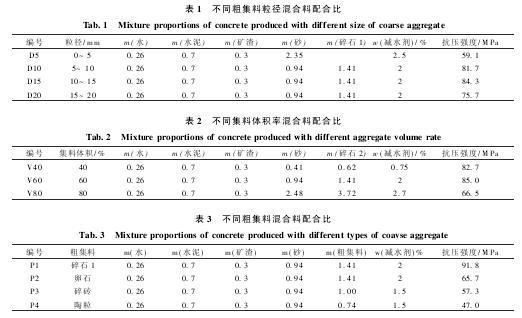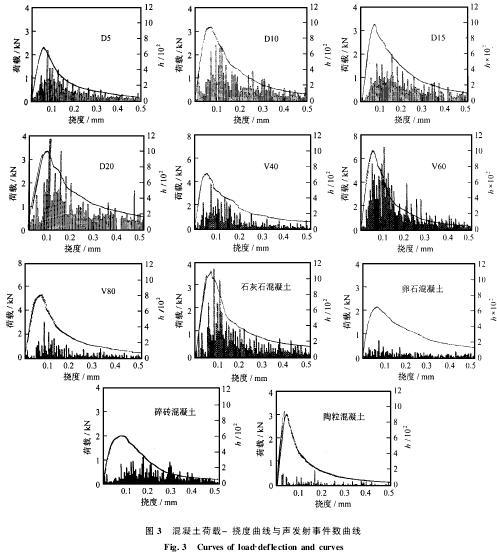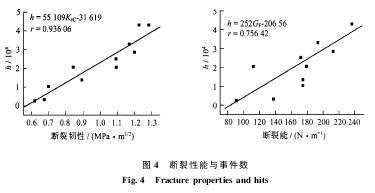Abstract: the calculation of different coarse aggregate size, aggregate volume ratio and the different kinds of coarse aggregate concrete fracture energy and fracture toughness; The number of acoustic emission events when testing concrete fracture; Analyzed the aggregate properties affect the performance of concrete fracture and the relationship between the number of acoustic emission events and fracture properties.
Keywords: concrete; High strength concrete. Aggregate; Crack; Acoustic emission
Aggregate concrete is an important part, usually accounted for more than 75% of the total volume of concrete, form the concrete skeleton, so its in a certain extent determines the fresh concrete rheological property, strength of hardened concrete and concrete durability [1].
Previous studies aggregate effect on mechanical properties of concrete, the object of study for ordinary concrete. Ordinary concrete due to the low interface strength, concrete damage is occurred in the interface, the characteristics of the aggregate impact is not big. High strength concrete is due to interface to strengthen, concrete damage may cut aggregate, and the influence of the characteristics of the aggregate is larger; And previous research method is relatively single, mainly for strength of concrete, this paper, by using the load deflection curve of concrete and concrete acoustic emission events figure study of concrete fracture. In recent years, the use of concrete strength is higher and higher, so the aggregate effect on the properties of high strength concrete fracture is of great significance to improve the performance of concrete.
1 test design
1.1 raw materials
Cement for Shanghai wusong cement production of # 525 ordinary Portland cement; Ultrafine slag for hunan ShaoFeng production of superfine slag cement group co., LTD Sand for medium sand, fineness modulus of 2.8; Gravel 1: size is 5 ~ 20 mm hard rock, gravel gradation is good, the silt content < 0.1, crushing index by 8.3%, the rock screen is divided into 5 ~ 10 mm, 10 ~ 15 mm, 15 ~ 20 mm gap graded; Gravel 2: size is 5 ~ 20 mm hard limestone, gravel gradation is good; Pebble: size is 5 ~ 20 mm hard limestone, gravel gradation is good; Rubble: particle size is 5 ~ 20 mm, loose volume quality for 811 kg · cm - 3, volume quality of 1 630 kg · cm - 3, bibulous rate is 13.1%; Ceramsite: size is 5 ~ 15 mm, loose volume quality of 833.5 kg · cm - 3, quality as the apparent volume 1, 400 kg · cm - 3, bibulous rate is 14%, crushing value of 18.2%, cylinder pressure strength of 8.75 MPa; Water reducing agent for kao high efficiency water reducing agent.
1.2 proportion of mixture
Considering the aggregate properties influence the performance of concrete fracture, this paper is divided into three groups of experiments of different particle size of the coarse aggregate concrete test respectively; Different aggregate volume rate of concrete test; Test different coarse aggregate concrete, the mix proportioning are shown in table 1 to table 3.

1.3 test method
Calculation formula of concrete fracture energy by RILEM recommended formula

Type: the omega zero for the area under the load deflection curve, n. m. M for beam span between dead weight, kg; The delta 0 for the deformation of the beam eventually destroyed m; Alig for the area of the concrete fracture ligament, the m2.
According to the ASTM standard, press type calculation of concrete fracture toughness:

Type: Pmax for concrete load deflection curve peak load, N, a, d, b, s respectively concrete specimen notch depth, thickness, width and machine protection spacing.
Fracture energy and fracture toughness of the concrete, using 100 mm * 100 mm * 515 mm specimen, and its net span is 400 mm, notch depth of 50 mm. The three point bending test, using emission meter records concrete fracture synchronously on the number of acoustic emission events h. test unit figure and the acoustic emission probe location as shown in figure 1, figure 2, including stationing reverse symmetry below probe on the concrete specimens.

2 the results
2.1 concrete load deflection curve and acoustic emission curve (see figure 3)
Force in the process of concrete material, the material plastic deformation occurred, from the crack to crack extension until the instability of fracture. In the meantime, the release of strain energy, some in the form of stress wave transmission and transmission, produce acoustic emission. Acoustic emission characteristics of concrete material and the power degree, carrying its organization structure change of dynamic information, usually by acoustic emission events to represent the characteristics of acoustic emission [2]. In this paper, the concrete load deflection curve and acoustic emission curve drawing in the same figure, this comparison the concrete characteristics of acoustic emission and the relationship between fracture properties

2.2 the test results
Using (1) with type (2) can be computed fracture energy and fracture toughness of concrete, concrete by acoustic emission events curve can get the number of acoustic emission events during the concrete fracture, such as table 4.

3 test results analysis
3.1 concrete aggregate properties and fracture performance relationship
Concrete specimen stress, once the critical stress, the crack to expand in unstable way. Cracks in the concrete expansion through different phase extension, the fracture properties of each phase is different, its extension is usually 1) in the following three ways:
(1) all cut sets of crack is expected to continue to expand.
(2) the crack all around aggregate and hardened cement paste interface extension.
(3) to cut off the aggregate of crack and crack around the aggregate and hardened cement paste interface extension exist at the same time.
In this paper, the character of crack in the concrete aggregate of the influence of scaling is discussed.
In high strength concrete, mortar and interface strength of coarse aggregate are strengthened. Crack propagation in coarse aggregate crack phenomenon. Always crack propagation along the path of minimum energy consumption, crack through the aggregate total energy consumption by less than the total energy consumption by around the interface extension, so in high strength concrete, the fracture way in many cases is to cut off the aggregate. At the same water-cement ratio and aggregate volume rate, the greater the particle size of aggregate, the more you will cut off the energy dissipations of the aggregate, fracture energy and fracture toughness as coarse aggregate fraction increases, and the fracture process of concrete can be seen from the figure 3 acoustic emission events with the increase of particle size of aggregate and become more "intense".
Aggregate volume rate increased from 40% to 40%, from the concrete fracture, found that the aggregate has been cut off. Generally speaking, aggregate of fracture surface energy should be greater than the fracture surface energy of hardened cement paste and aggregate rate increases, the volume of concrete fracture surface increases. By table 4 shows volume rate increased from 40% to 60%, concrete fracture and fracture toughness increase, the noise emission from the view of figure 3 events significantly stronger. However, when the aggregate volume rate increased from 60% to 60%, due to the large aggregate volume fraction, the interface strength drops, a concrete fracture can be observed that the vast majority of crack along the aggregate interface extension. In this case, the interfacial fracture surface energy is much smaller than that of hardened cement paste fracture surface energy, aggregate rate increases, the volume of concrete to reduce the fracture surface. The table 4 shows that concrete fracture energy, fracture toughness and decreases in the number of acoustic emission events at the same time as you can see in figure 3, with the increase of volume rate of acoustic emission events become a "flat".
From the rubble of the concrete and brick and concrete fracture, it can be seen that the crack to cut off the aggregate extension. Rock fracture surface can be greater than the fracture surface of hardened cement paste, fracture surface energy and the blocks of hardened cement paste is much higher than the fracture surface energy, can be seen from table 4 stone concrete fracture can count and acoustic emission events are greater than the brick and concrete. Due to the low pebble concrete interface strength, from the fracture surface, it can be seen along the interface crack cut aggregate and crack extension exist at the same time, but the crack is mainly along the aggregate expansion, so the pebble concrete fracture energy than rubble concrete fracture energy. So the stone concrete fracture energy and fracture toughness and acoustic emission incidents were greater than the pebble concrete. Ceramsite concrete as coarse aggregate strength is low and the interface strength is low, so the fracture performance worst. Comparison of acoustic emission events figure, crushed stone concrete fracture during the process of acoustic emission events are the most "violent", ceramsite concrete most "gentle" launch event.
3.2 fracture performance relationship with acoustic emission
Further study of fracture energy, fracture toughness and the number of acoustic emission events, available in figure 4. Fracture toughness and the incident number has a good linear correlation, fracture energy and the number of events linear correlation times. The fracture energy of concrete is refers to the fracture of concrete needed per unit area of surface energy, fracture toughness is used to represent concrete block crack instability expansion ability, while number according to the concrete fracture when the strength of the release of the stress wave. All three are from different angles in this paper, the crack in the concrete expansion. In this paper, the number of acoustic emission events and concrete fracture energy and fracture toughness as linear relationship.

4 conclusion
(1) coarse aggregate particle size increases, fracture energy and fracture toughness of concrete increases, the number of acoustic emission events increased, the fracture process of acoustic emission events become "heavy". Aggregate volume rate increased from 40% to 40%, the fracture energy and fracture toughness of concrete increases, acoustic emission events increase in the number; But volume rate increased to 80%, fracture energy and fracture toughness of concrete is reduced, number of acoustic emission events is reduced, the aggregate volume fraction was 60%, the fracture acoustic emission events during the "fierce". Different kinds of coarse aggregate concrete fracture energy, fracture toughness and the size of number of acoustic emission events in order to rubble concrete, pebble and ceramsite concrete, concrete, brick and concrete rubble concrete fracture during the process of acoustic emission events are the most "violent", ceramsite concrete most "gentle" launch event.
(2) there are three kinds of crack extension in the concrete way: all cut sets of crack is expected to continue to expand; Crack all around aggregate and hardened cement paste interface extension; Cut off the aggregate of crack and crack around the aggregate and hardened cement paste interface extension. Monolith rate under the condition of a certain volume, cut off in the high strength concrete aggregate of crack extension; Aggregate particle size under certain conditions, aggregate volume rate at 40% and 60%, to cut off the aggregate extension of crack, and the aggregate volume rate increased to 80%, to cut off the aggregate of crack and crack around the aggregate and hardened cement paste interface extension exist at the same time; Aggregate diameter and aggregate volume rate under certain conditions, gravel in the concrete, crack all cut sets is expected to continue to expand; And pebble in the concrete, crack cut aggregate and cracks around the aggregate and hardened cement paste interface extension exist at the same time; The blocks and the intensity of haydite aggregate itself is very poor, so the crack expanding will cut off the aggregate. Aggregate properties affect the crack propagation way, thus influence the fracture energy and fracture toughness of concrete and ae events.
(3) the number of acoustic emission events and concrete fracture energy, fracture toughness, a certain linear correlation.
References (abbreviated)







